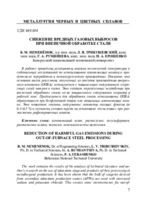| dc.contributor.author | Неменёнок, Б. М. | ru |
| dc.contributor.author | Трибушевский, Л. В. | ru |
| dc.contributor.author | Румянцева, Г. А. | ru |
| dc.contributor.author | Ерошенко, П. А. | ru |
| dc.coverage.spatial | Минск | ru |
| dc.date.accessioned | 2023-04-28T13:40:33Z | |
| dc.date.available | 2023-04-28T13:40:33Z | |
| dc.date.issued | 2023 | |
| dc.identifier.citation | Снижение вредных газовых выбросов при внепечной обработке стали = Reduction of harmful gas emissions during out-of-furnace steel processing / Б. М. Неменёнок [и др.] // Металлургия : республиканский межведомственный сборник научных трудов / редкол.: И. А. Иванов [и др.]. – Минск : БНТУ, 2023. – Вып. 43. – С. 7-15. | ru |
| dc.identifier.uri | https://rep.bntu.by/handle/data/127475 | |
| dc.description.abstract | В работе приведены результаты анализа технической литературы и собственных исследований по использованию алюминиевых шлаков и продуктов их переработки в металлургическом производстве. Показано, что основная масса реагентов, полученных из отходов производства вторичного алюминия (ОПВА), используется с повышенным содержанием хлористых солей натрия и калия. Это создает определенные неудобства при внепечной обработке стали из-за повышенного содержания хлоридов в рабочей зоне. Предлагается для обработки стали использовать ОПВА, образующиеся при бесфлюсовой плавке или отвальные алюминиевые шлаки. Это позволяет снизить содержание остатков солевых флюсов до 0,3–0,5 % и улучшить условия труда на установках «печь–ковш» при разжижении рафинировочных шлаков. | ru |
| dc.language.iso | ru | ru |
| dc.publisher | БНТУ | ru |
| dc.title | Снижение вредных газовых выбросов при внепечной обработке стали | ru |
| dc.title.alternative | Reduction of harmful gas emissions during out-of-furnace steel processing | ru |
| dc.type | Article | ru |
| local.description.annotation | The work contains the results of the analysis of technical literature and author's research on the use of aluminum slags and products of their processing in metallurgical production. It has been shown that the bulk of reagents derived from secondary aluminum production wastes (APWs) are used with increased sodium and potassium chloride. This creates some inconvenience for out-of-furnace steel treatment due to the increased chloride content in the working area. It is proposed for steel processing to use APWs formed during flux-free melting or dump aluminum slags. This allows to reduce the content of salt fluxes residues to 0.3–0.5 % and to improve working conditions at ladle furnaces when liquefying refining slags. | ru |

